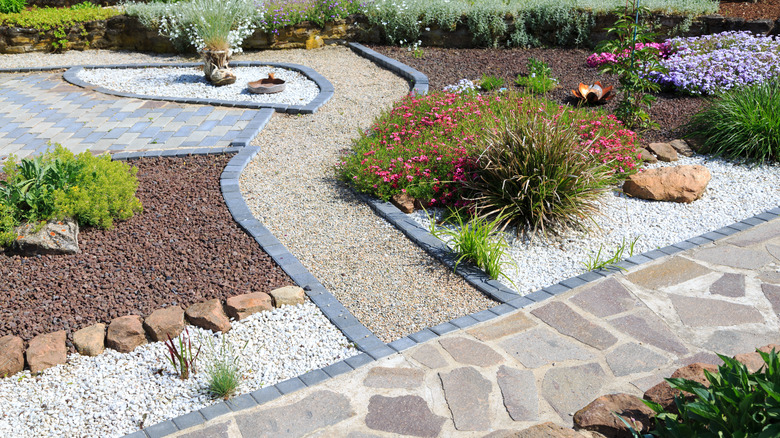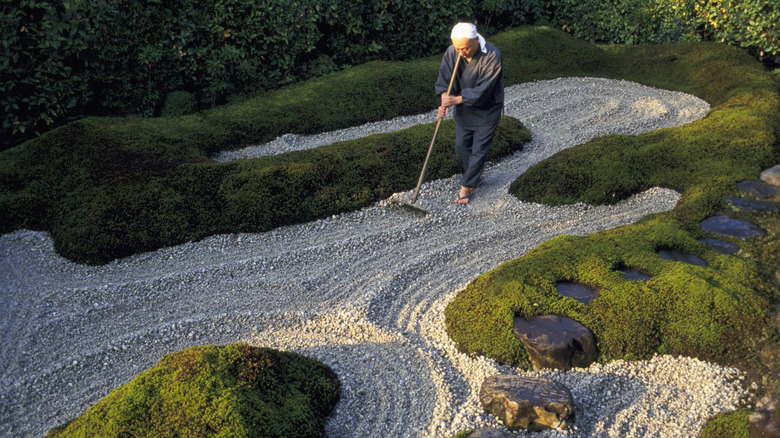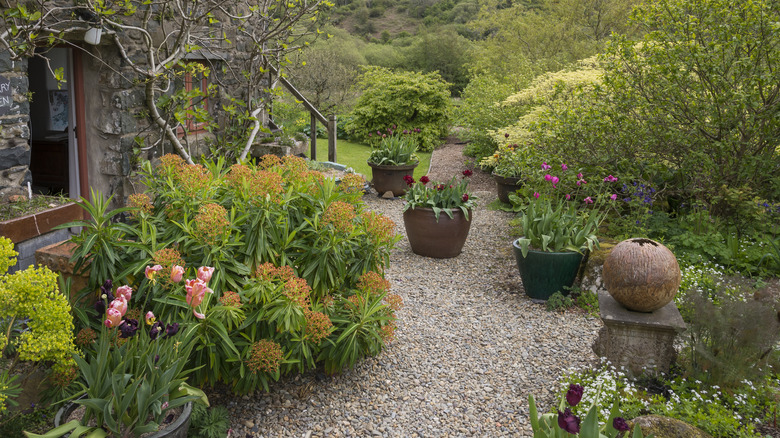How To Care For A Low-Maintenance Gravel Garden In Your Backyard
We may receive a commission on purchases made from links.
Gravel gardens can be just as lush and gorgeous as their traditional turf counterparts, and the hard landscaping element gives them an intriguing rugged — yet natural — appearance. Apart from their aesthetic appeal, gravel gardens are known for needing much less of your time, attention, and resources than a turf garden. For example, you don't need to use nearly as much water to keep a gravel garden healthy; nor is it as expensive to install as turf. But despite these benefits of trading out your turf for a gravel garden, these spaces still need a bit of specialized care.
For one, gravel gardens can be susceptible to accumulating dead leaves, which are quite problematic for the gravel. Also, without proper care, weeds can start sprouting through the gravel, and may compete with your plants for nutrients, water, and light. Finally, the plants you grow in the gravel garden need a bit of love to thrive their best. But don't worry, taking care of this type of garden is still relatively effort-free. And, as you'll see, maintaining a gravel garden is even easier if you implement a few simple strategies while creating this landscaped space. We'll walk you through all the specifics of gravel garden maintenance below.
How to keep a gravel garden clean and control weeds
If you have trees in the yard, it's possible that their leaves will end up strewn around your gravel garden. In the fall, you may find the dead leaves particularly problematic. Not only do they clutter up the gravel walkways, but they may cause some of the lighter-colored stones to loose their natural color. That's why having a leaf blower is really worth it if you've got a gravel garden. These devices offer the simplest way to get rid of leaves without upheaving the gravel. That said, don't forget that gravel — unlike turf — is more easily disturbed. So, to avoid blowing your gravel away and creating bald spots, use the leaf blower on its lowest setting. If you notice that bald spots still appear after you're done blowing the leaves away, top the gravel up a bit and rake it into rows. This procedure should leave the gravel paths looking clean and fresh.
In a gravel garden, effective weed control actually starts before you lay the crushed stones down. To make weeding easier, create a weed barrier using landscape fabric, like this option from The Home Depot. You can even use this fabric to cover your flower beds, allowing cutouts wide enough to facilitate planting. However, this tactic only works if the plants you're growing don't need to self-seed. If you didn't place landscaping fabric before laying down the gravel, you can resort to using weed killers to keep the pesky plants at bay.
How to choose and care for low-maintenance plants in your gravel garden
To make your gravel garden as low-maintenance as possible, start by choosing plants that thrive in such conditions and demand little care. You can easily find shrubs, herbs, and ornamental plants that are well suited for growing in a low-upkeep gravel yard. Among herbaceous perennials, some ideas for having the best gravel garden include catmint (Nepeta), Algerian iris (Iris unguicularis), and evening primrose (Oenothera). If you're interested in giving the garden a vertical dimension, you can consider shrubs such as the rockrose (Cistus), St. John's wort (Hypericum), and lavender (Lavandula). Ornamental grasses such as fountaingrass (Pennisetum) and feathergrass (Stipa) are also excellent options.
When choosing plants, take into account the type of gravel you're using. For instance, if you have limestone in the garden, it's best not to grow plants that thrive in acidic conditions. Alternatively, you can grow these plants in pots in a mix that suits their acid-loving nature.
Gravel gardens may require less maintenance than a traditional yard. However, this doesn't mean that you can neglect your plants. Irrigate them as needed, and be sure to weed the beds aggressively until the plants are well established. When you maintain the gravel patches, take good care not to push the gravel too close to the base of the plants, as too much of the stones around them could suffocate them. You can avert this issue by creating small heaps of soil that sit above the gravel and planting the vegetation there.


